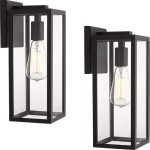What Finish Should I Use On Outdoor Wood Furniture?
Outdoor wood furniture adds warmth and charm to any patio or deck, but it requires special care to withstand the elements. The sun, rain, snow, and temperature fluctuations can cause wood to crack, warp, and fade. A protective finish is essential for maintaining the beauty and longevity of your outdoor furniture. Choosing the right finish depends on the type of wood, the desired look, and the level of protection you need.
Types of Wood Finishes
There are several types of finishes available for outdoor furniture, each with its own advantages and disadvantages. Here are some common options:
- Oil-based finishes: These finishes penetrate the wood, providing a natural look and feel. They are also water-resistant, but they require frequent reapplications. Common oil-based finishes include linseed oil, tung oil, and teak oil.
- Water-based finishes: These finishes are environmentally friendly and dry quickly. They offer good protection from UV rays and water, but they may not be as durable as oil-based finishes.
- Polyurethane finishes: These finishes are very durable and weather-resistant. They come in both oil-based and water-based formulations. Polyurethane can create a glossy or satin finish.
- Varnish finishes: These finishes are similar to polyurethane but they offer a more natural look. Varnishes also come in oil-based and water-based options.
- Stain finishes: Stains are designed to color the wood without hiding its natural grain. Stains can also be used as a base for other finishes like polyurethane or varnish.
Factors to Consider When Choosing a Finish
When choosing a finish for your outdoor wood furniture, consider the following factors:
1. Wood Type
Different types of wood have different properties and require different types of finishes. For example, teak is naturally resistant to rot and insects, so it may only need a simple oil finish. Softwoods, like pine, are more prone to damage and require a more durable finish, like polyurethane.
2. Desired Look
Do you want a natural look that highlights the wood grain or a glossy finish that protects against the elements? Oil-based finishes tend to create a more natural look, while polyurethane and varnish provide a more protective, glossy finish. Stains can add color without covering up the wood grain.
3. Level of Protection
The level of protection you need depends on the climate and the amount of wear and tear your furniture will experience. If you live in a humid or rainy climate, you'll need a finish that is highly water-resistant. If your furniture is exposed to direct sunlight, you'll need a finish that offers UV protection.
4. Maintenance Requirements
Oil-based finishes typically require more frequent reapplication than water-based or polyurethane finishes. Consider how much time you are willing to spend on maintenance before choosing a finish.
Application and Maintenance
Once you've chosen your finish, it's important to apply it correctly. Always follow the manufacturer's instructions carefully. Most finishes require the wood to be clean and dry before application. You may also need to sand the wood to create a smooth surface.
After the finish has dried, be sure to maintain it regularly. This may involve cleaning the furniture with mild soap and water or reapplying the finish as needed. By following these tips, you can ensure that your outdoor wood furniture stays beautiful and functional for years to come.

What S The Best Outdoor Finish Wood

How To Treat Wood For Outdoor Use 3 Methods Explained

When And How Often To Treat Outdoor Wood Finishes Direct

Outdoor Finishes Popular Woodworking

6 Ways To Treat Wood For Outdoor Use Pine And Poplar

What Wood To Use For Outdoor Furniture Woodworking Blog S Plans How

How To Treat Wood For Outdoor Use 3 Methods Explained

The Best Finishes For Outdoor Wooden Furniture

How To Finish Raw Wood Furniture Without A Sprayer

Easiest Way To Finish Outdoor Furniture The Awesome Orange







